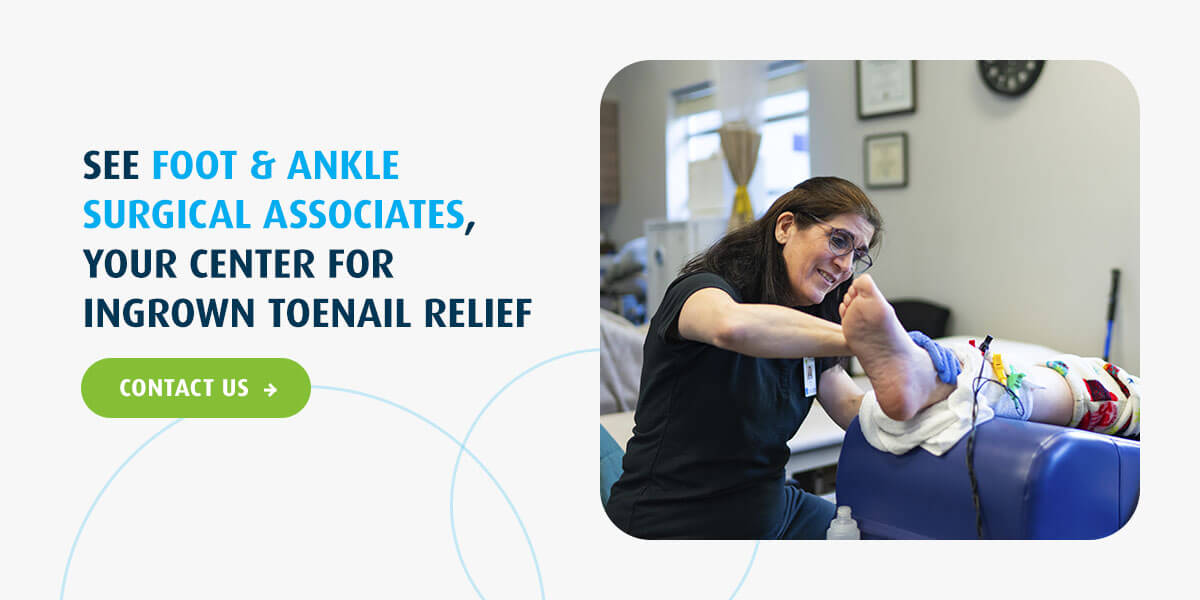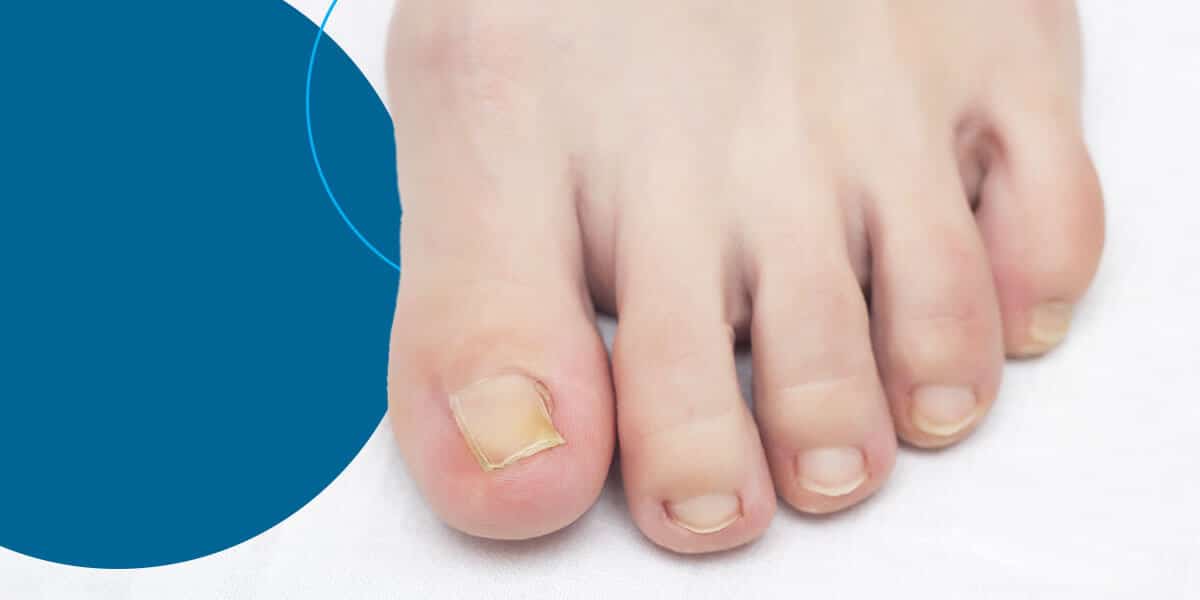An ingrown toenail can be painful, especially when the nail’s edge grows into your skin. You can become painfully aware of a toe you don’t usually notice, and as the nail grows, it can cause more irritation and pain.
An untreated ingrown toenail can cause a break in the skin, allowing bacteria to enter and cause an infection. An infection in the toe will feel even more painful, becoming hot, swollen or red. Treating ingrown toenails and learning how to prevent them in the future is essential for your feet’s health and overall well-being. Continue reading about how to identify an ingrown toenail, its causes and how you can fix the problem and prevent it from occurring again.
Symptoms of Ingrown Toenails
Ingrown toenails are a common condition most people experience at least once. If you’ve ever noticed your toenail’s side or corner is inflamed or red, it may be ingrown. You could have this problem for many reasons, including wearing tight shoes or having nails that naturally curve toward the skin.
Most people have the same symptoms of an ingrown toenail, which include:
- Pain or tenderness around the affected toe
- Inflamed, red skin
- Swelling
- Signs of infection, such as pain, heat, oozing pus, bleeding or a foul smell
If you notice signs of an ingrown toenail, taking care of it as soon as possible is essential to prevent the condition from worsening. If you leave an infection untreated, you could require minor surgery. It could even spread to the bone in your toe, creating additional problems that require more in-depth solutions.
What Causes an Ingrown Toenail?
There are different known causes of an ingrown toenail, including the following.
- Genetics: Heredity plays a significant role in shaping your toenails. If your parents frequently struggle with ingrown toenails, you’re more likely to have trouble with the condition.
- Tight shoes: A typical cause of ingrown toenails is ill-fitting shoes. If you wear tight shoes or socks, it creates the ideal environment for the condition to develop. Teens and adolescents can often get ingrown toenails this way as they go through growth spurts and may end up outgrowing their shoes.
- Trauma or injury: Injuring your toe by stubbing, jamming or dropping something on it can cause an ingrown toenail. Participating in activities that put repeated pressure on your toes, such as ballet, soccer or running, can also make you more vulnerable to the condition.
- Cutting too short: Another common reason for ingrown toenails is due to trimming your toenails too short. Short nails encourage the surrounding skin to fold over the toenail, making it easier to get the condition. When grooming, cut in a straight line and try to leave a bit of extra growth.
- Pedicures: Sometimes, getting a pedicure can lead to an ingrown toenail. If you enjoy getting pedicures, ensure you’re seeing an experienced technician. You could develop the condition if someone is too aggressive when cutting back a toenail.
- Poor circulation: Some adults with conditions that cause poor circulation could be more likely to develop an ingrown toenail. People with a history of tobacco use, heart disease or diabetes should see their ankle and foot doctor if they’re experiencing regular ingrown toenails.
How to Fix an Ingrown Toenail

In most cases, you can treat an ingrown toenail at home, and it will go away on its own. If you don’t notice any signs of infection, you can try to let the nail grow out and see if it resolves without treatment. However, if you notice an infection has started or want to treat the pain or discomfort, there are methods you can use to help fix the toenail. Here are some ingrown toenail treatments you can try to remedy the condition.
- Soaking: One way you can treat ingrown toenails is by soaking your foot in warm water with a mild detergent or Epsom salt. After soaking, you can apply an antibiotic ointment and bandage it to prevent infection.
- Use cotton or dental floss: After you soak your toe, you can try placing cotton or dental floss under the edge of the nail to help it grow above the edge of the skin.
- Apply petroleum jelly: Another option after soaking is applying petroleum jelly. Once you’ve used the jelly, you can bandage the area to keep it covered and prevent bacteria from entering.
- Take pain relievers: You can reduce pain and inflammation by taking over-the-counter pain relievers such as acetaminophen or ibuprofen.
- Remove the nail: You should only try this method if there’s no infection. First, soak your toe with Epsom salt to make the skin more tender and reduce swelling or inflammation. Next, you can use clean nail-cutting tools to try and clip the affected nail. If you can do this, you should apply an antibiotic ointment and bandage the area to prevent infection.
How to Prevent Ingrown Toenails
If you’re worried about developing an ingrown toenail and want to prevent it from occurring, try these methods.
- Avoid cutting too short: Cutting your nails too short is one of the leading causes of ingrown toenails. You should also cut straight across, whether you’re trimming them yourself or having someone else do it for you.
- Wear correctly fitting shoes: You can prevent ingrown toenails by wearing appropriately sized shoes. Small shoes will put too much pressure on your toes. If you have nerve damage, you may be unable to tell if your shoes are too small. You should get your feet properly fitted for their size, so you’re sure you’re choosing shoes that won’t create the potential for ingrown toenails.
- Wear protective footwear: If you participate in activities that could put more pressure on your toes, such as running or ballet, you should wear protective footwear when possible, such as steel-toed shoes or those specifically designed to protect your feet based on the activity.
- Regularly look at your feet: If you have a specific condition like diabetes that makes you prone to ingrown toenails, you should keep an eye on your feet. Look for signs of ingrown toenails or other foot issues, and see your doctor if you’re experiencing chronic problems.
When to Make an Appointment for an Ingrown Toenail
If you’ve tried different home remedies without success, you should schedule an appointment with your doctor. A professional can determine the cause and help you find the proper treatment.
If you have a condition like diabetes that causes poor circulation in your feet, an ingrown toenail can quickly become a more severe issue. You shouldn’t wait to see a doctor if you’re someone with one of these conditions to prevent an infection that spreads or requires surgical intervention.

See Foot & Ankle Surgical Associates for Ingrown Toenails
If you need to see a doctor for your ingrown toenail, Foot & Ankle Surgical Associates can help. Our podiatrists can evaluate your condition and offer a treatment plan to help you find relief, whether this is the first time you’ve experienced this condition or it’s become chronic. You can rest assured that we’ll provide high-quality care using the latest techniques and non-invasive methods.
We’ll look for the least invasive approach to treat your ingrown toenails, only resorting to surgical options as a last resort. Contact us today to learn more about how we can help you find relief!





